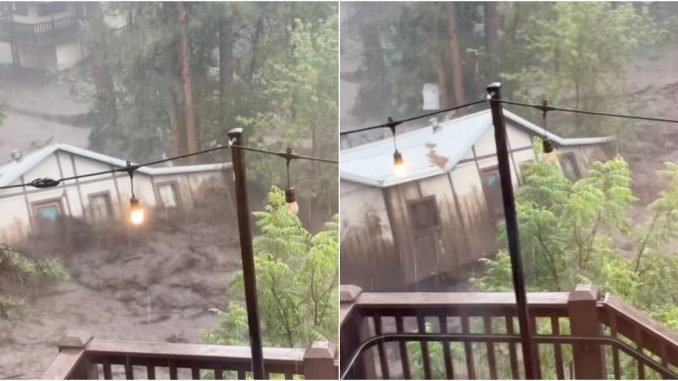
| Published July 10, 2025
Flash floods prompted by monsoon rains kill at least three, including two children, with search operations continuing.
🌊 What Happened?
- A powerful “atmospheric river” stalled over the Sangre de Cristo Mountains, unleashing intense rainfall that dropped up to five feet (1.5 m) of water in narrow valleys in just hours .
-
The river running through the mountain town punched a hole through a bridge and surged downstream, inundating communities and trapping residents quickly .
📍 Affected Areas & Casualties
-
Northern New Mexico’s mountain towns and villages were hit hardest, especially those along small creeks and tributaries .
-
At least three people have been confirmed dead:
-
A house was swept away, tragically carrying one person with it .
-
Other fatalities occurred in low-lying areas overtaken by the flash flood .
-
🆘 Emergency Response & Aftermath
-
Municipal crews are working on restoring damaged bridges and roads; some are still impassable .
-
Search and rescue efforts are underway to locate missing residents, but fear is growing for those who may still be unaccounted for .
⚠️ Risks & Expertise
-
The event is consistent with studies showing flash floods in mountain regions become more frequent and intense with climate change, as warmer air carries more moisture .
-
Experts warn that mountain communities in New Mexico and elsewhere must reinforce infrastructure and improve emergency systems to cope with such sudden storms.
🚧 On the Ground: What Locals Are Facing
| Issue | Details |
|---|---|
| Infrastructure | Washed-out bridges, blocked roads, power outages |
| Evacuations | Residents from flood zones were ordered to leave temporarily |
| Risk of landslides | Saturated soil poses danger of further slides |
 Implications:
Implications:
🌪️ ENVIRONMENTAL IMPLICATIONS
1. Post-Wildfire Flood Vulnerability
-
The burn scar from recent wildfires, particularly around Ruidoso, left soil unable to absorb rainwater, triggering a deadly runoff.
-
This shows a dangerous cycle: wildfire weakens the land → rain follows → flash floods intensify.
🧠 Implication: Communities near recent burn zones are at elevated long-term risk, even with moderate rainfall.
2. Rapid Water Table Shifts & Riverbank Erosion
-
The Rio Ruidoso rose more than 19 feet in just 30 minutes. This erosion threatens roads, water pipelines, and long-term ecological stability.
-
Sediment and debris swept downstream may disrupt aquatic ecosystems for years.
🧍 SOCIAL & COMMUNITY IMPLICATIONS
3. Loss of Life & Homes
-
At least three deaths, including children, and homes were swept away—leaving families homeless and grieving.
-
Emergency responders executed over 85 rescues, stretching local resources and exposing readiness gaps.
4. Evacuation Trauma
-
Many residents in Ruidoso and surrounding areas were evacuated on short notice, leading to psychological distress, displacement, and community disruption.
🧠 Implication: Rural towns need better early-warning systems, evacuation routes, and trauma response plans.
💵 ECONOMIC IMPLICATIONS
5. Infrastructure Damage
-
Bridges collapsed, roads were destroyed, and homes were lost—creating millions of dollars in rebuilding costs.
-
Small businesses in affected areas may shut down or lose revenue during lengthy repairs.
6. Insurance & Federal Relief
-
Homeowners may face delays or denials in insurance payouts, particularly if flood coverage was not included.
-
FEMA assistance and state emergency funds will be tapped, increasing public financial burden.
🏛️ POLITICAL & POLICY IMPLICATIONS
7. Scrutiny of Local Preparedness
-
Municipal and state officials will face tough questions about infrastructure maintenance, response speed, and planning for extreme weather.
-
Some may push for updated zoning laws and limits on building in flood-prone areas.
8. Climate Adaptation Debate Intensifies
-
While some blame climate change for increasing monsoon intensity, others will point to land mismanagement, forestry neglect, or water policy failures.
-
Expect federal debates over how to allocate resources toward climate resilience vs. emergency reaction.
 Overall Takeaway:
Overall Takeaway:
The catastrophic flash flooding in New Mexico is more than just a weather tragedy—it’s a harsh reminder of how vulnerable mountain towns remain in the face of compounding natural threats. The deadly surge of the Rio Ruidoso, fueled by intense rain and burn-scarred terrain, revealed serious gaps in emergency readiness, infrastructure resilience, and post-wildfire recovery planning.
While some point to climate change as the driving factor behind the storm’s severity, others highlight the consequences of forest mismanagement, weakened soil conditions, and poor land-use policies. Regardless of the cause, the outcome is clear: lives were lost, homes destroyed, and communities devastated.
The path forward must include not just rebuilding, but rethinking. Early-warning systems, stronger flood barriers, smarter zoning, and better land stewardship are no longer optional—they’re urgent. What happened in New Mexico could happen elsewhere—and next time, the stakes may be even higher.





Be the first to comment